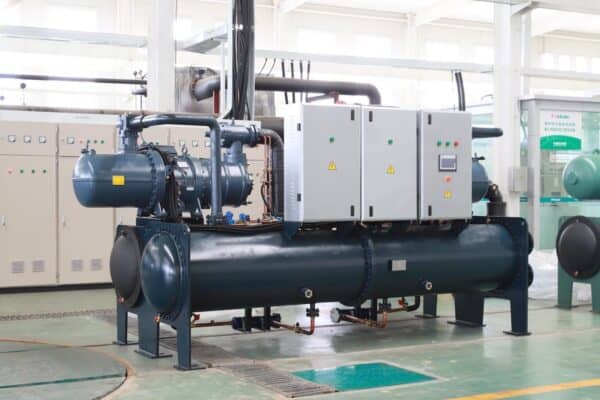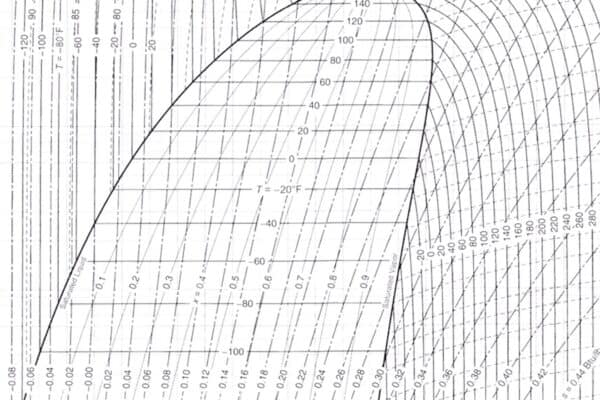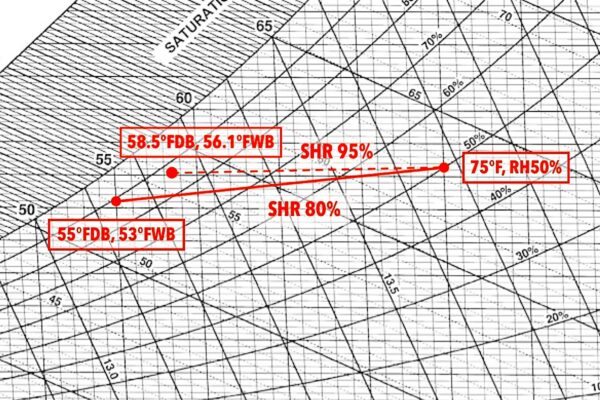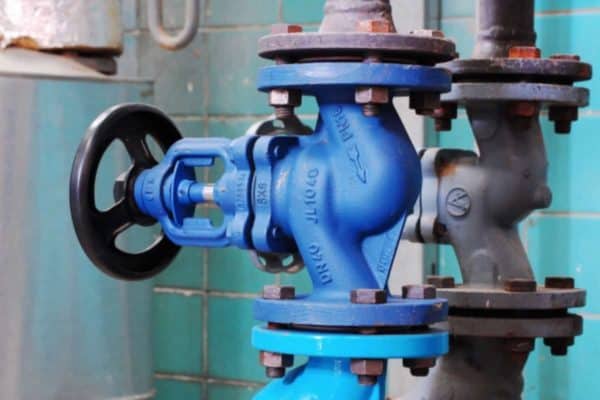How to Size AHU Cooling Coil? (Design Calculation)
Sizing the cooling coil of an AHU is one of the essential HVAC design calculations. The calculated cooling load does not equal to the capacity of the AHU cooling coil. So, how do you size an AHU cooling coil?
To size an AHU cooling coil, first, determine the required airflow. Then, identify the on coil and off coil temperature of the cooling coil and use the psychrometric chart to find the enthalpy difference. Finally, multiply 4.5 by the airflow and the enthalpy difference to get the AHU cooling coil size.
Many engineers thought that the cooling load calculation result is the AHU cooling coil size. But, that’s not true. We need to account for the outdoor air as well as the heat gain in the duct.
Using Psychrometric Chart to Size AHU Cooling Coil
AHU cooling coils can be sized using software or manually using the psychrometric chart. We estimate the cooling coil size for various preliminary design purposes. During construction, suppliers will use their software to determine the actual cooling coil size.
Below is an example of how to use the psychrometric chart to size an AHU cooling coil. There are a few things we need to obtain but basically, we want to identify the enthalpy of the air before and after the cooling coil. Then, we’ll use a formula to calculate the cooling coil capacity.
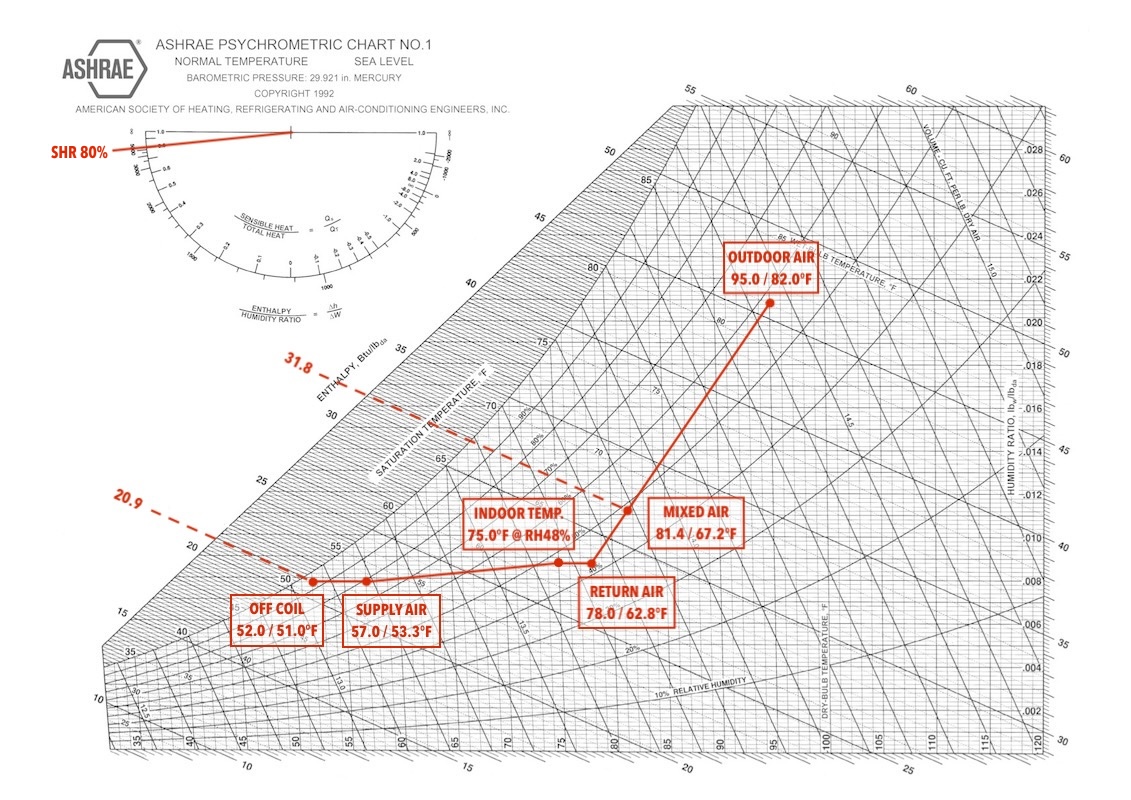
From the above chart, the off coil enthalpy is 20.9 btu/lb and the on coil enthalpy is 31.8 btu/lb. Thus, the enthalpy difference (Δh) is 11.0 btu/lb.
An AHU cooling coil capacity can be calculated using the following formula:
Coil Load = 4.5 x Airflow (cfm) x Δh (btu/lb)
Based on the above formula, we need to determine the AHU airflow as well. Hence, the following formula can be used to calculate AHU airflow:
Airflow = Sensible Load / (1.08 x ΔT)
Delta T (ΔT) is the temperature difference between the desired indoor temperature and the supply air temperature. So, we need to determine the supply air temperature and identify the sensible load before we can calculate the AHU airflow.
AHU Cooling Coil Design Calculation
To size an AHU cooling coil, there are many preliminary requirements. Nonetheless, if we do one step at a time, the process will be less complex and manageable.
1. Calculate the Cooling Load
From the airflow formula, we know that a sensible load is required. So, we need to perform a cooling load calculation. Traditional btu/hr/sqft estimation won’t be able to provide us the sensible-latent separation.
Cooling load calculation is a complex process. To get an overview, read my article Cooling Load Calculation Guide. If you want to learn actually how to perform the calculation, consider enrolling in my RTS Cooling Load Calculation Course.
Nonetheless, assuming that an office space has a sensible load of 45,000 btu/hr and a latent load of 11,250 btu/hr. Thus, the total cooling load is 56,250 btu/hr.
Here, we can calculate the sensible heat ratio (SHR) as follows:
SHR = Sensible Load / Total Cooling Load
SHR = 45,000 / 56,250
SHR = 80%
The sensible heat ratio is needed for us to draw the cooling slope as shown in the below chart:

The compass provided in the psychrometric chart is for us to draw the slope (gradient) based on the sensible heat ratio. Once we’ve drawn the sensible heat ratio at 85%, we can then draw another parallel line to indicate the cooling slope.
2. Determine the Supply Air Temperature
To calculate the AHU airflow, we also need the temperature difference between the desired indoor temperature and the supply air temperature.
For the desired indoor temperature, we generally use 75°F (24°C) at 40-60% relative humidity or comply with our project’s standard requirements. For example, some navy ships required the indoor temperature to be 73°F (23°C).
After we’ve set the indoor design conditions, we can either use a delta T of 18°F (10°C) or follow our project’s standard requirements to determine the required supply air temperature.
For example, in navy ships, ISO 7547 specifically mentioned that the supply air temperature shall not be 18°F (10°C) lower than the average space temperature. So, if the target space temperature is 75°F (24°C), the lowest supply air temperature allowed is 57°F (14°C).
3. Calculate the AHU Airflow
Once the sensible load, indoor temperature and supply air temperature are determined, we can proceed to calculate the required AHU airflow as follows:
Airflow = Sensible Load / (1.08 x ΔT)
Airflow = 45,000 / [1.08 x (75-57)]
Airflow = 2,315 cfm
Under most circumstances, we need to account for the outdoor air supply. Generally, we use 15 cfm/person but it can vary greatly depending on the activity performed and application requirements.
Assume that we have 31 people and each person requires 15 cfm of outdoor air. In total, the required outdoor air supply is 465 cfm. Therefore, the outdoor-to-return air ratio can be calculated as follows:
465 / 2,315 = 20%
Since the outdoor air ratio is 20%, the return air is 80%.
If there is an outdoor air supply, we need to use the mixed air temperature as the AHU’s on coil temperature. To determine the mixed air temperature, we need the outdoor design conditions and the return air temperature.
4. Determine the On Coil Enthalpy
Depending on the location, the outdoor design conditions vary. Assume that our outdoor design conditions is dry bulb 95°F (35°C) and wet bulb 82°F (28°C).
For the return air temperature, we need to account for the heat gain in the form of temperature rise in the return duct. To calculate the return duct temperature rise, use the following formula:
Return Duct Temperature Raise = (Duct Length x 0.5°F) / 100 ft
If the duct length is not known yet, we can assume a 3°F duct temperature rise. So, the return air temperature is 75°F + 3°F = 78°F (26°C).
With the return air temperature, outdoor air temperature and outdoor-return air ratio, the mixed air temperature can be calculated as follows:
Mixed Air Temperature = (95°F x 20%) + (78°F x 80%)
Mixed Air Temperature = 81.4°F (27.4°C)
Now, from the psychrometric chart, we connect the outdoor temperature point to the return air temperature point. Then, we identify the mixed air temperature point along this line.
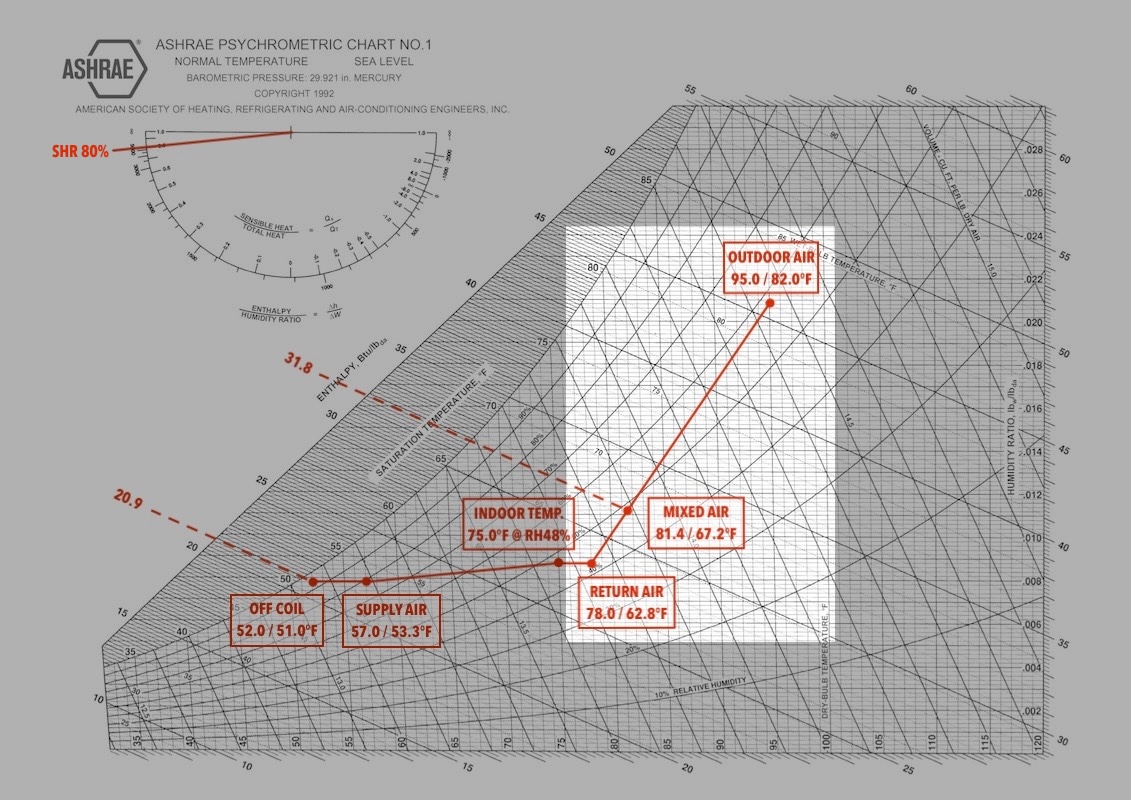
From the above chart, the mixed air temperature is dry bulb 81.4°F and wet bulb 67.2°F. With that, the on coil enthalpy is 31.8 btu/lb.
If the outdoor air is supplied by a separate fan (not directly drawn by the AHU), then the outdoor air fan motor temperature raise must also be included.
5. Determine the Off Coil Enthalpy
Earlier, we determined that the supply air temperature is 57°F (14°C). Using the same duct temperature raise of 3°F, the required temperature of the air at the AHU outlet is 54°F (12.2°C).
For supply duct temperature rise, we can use the following formula to calculate:
Supply Duct Temperature Raise = (Duct Length x 1.5°F) / 100 ft
Next, the fan motors of most AHUs are located in line with the air stream. Meaning the air will pass through the fan motor. Hence, we need to account for the heat gain from the fan motor.
For fan motor heat gain, we can assume a 2°F temperature rise. So, the required off coil temperature is 52°F (11°C) where the off coil enthalpy is 20.9 btu/lb.
6. Calculate the AHU Cooling Coil Capacity
With the on-off coil enthalpy and the airflow, we can calculate the AHU cooling coil capacity as follows:
Coil Load = 4.5 x Airflow (cfm) x Δh (btu/lb)
Coil Load = 4.5 x 2315 x (31.8-20.9)
Coil Load = 113,550 btu/hr
Therefore, for an office space with a total cooling load of 53,000 btu/hr at 20% outdoor air supply, the required AHU cooling coil size is 113,550 btu/hr or about 9.5 tons.
Factors that Affect AHU Cooling Coil Size
From all of the above, it is clear that AHU cooling coil size is affected by several factors which I summarize as follows:
- Total Cooling Load
- Indoor/Outdoor Design Conditions
- Outdoor Air Ratio
- Duct and Fan Motor Temperature Raise
Therefore, it is very important to keep the heat gain from the supply and return duct as low as possible with duct insulations to prevent high duct temperature rise.
In large systems, we can pre-cool the outdoor air to reduce the mixed air temperature and thus, the AHU cooling coil size. We can also modulate the outdoor air supply based on CO₂ level to save energy. If you’re interested in learning how to design a pre-cool and CO₂ system, consider enrolling in my Chilled Water System Design Course.
Other than that, the indoor/outdoor design conditions are based on location and the project’s standard requirements. We can’t use design conditions that favor smaller AHU cooling coils because we risk undersizing the system.
Most importantly, we must calculate the sensible and latent load separately to enable us to calculate the airflow, the subsequent parameters and ultimately, the AHU cooling coil size. So, consider enrolling in my RTS Cooling Load Calculation Course if you have yet to learn about load calculation.
Lastly, if you need me to help you in detail, consider my consultation service. I also provide professional system design, load calculation and AHU sizing services if you need them.
Frequently Asked Questions
- How to Know What Outdoor Design Conditions to Use? The outdoor design conditions can be obtained either by looking at your project’s standard requirements or using the data provided on ASHRAE METEO. The ASHRAE’s data can be confusing if you’re not familiar with it but, If you enroll in my RTS Cooling Load Calculation Course, you’ll learn how to use the ASHRAE METEO design conditions in detail.
- What is the Total Airflow for the AHU? The AHU airflow is 2,315 cfm. Out of it, 20% is outdoor air and 80% is return air. So, an exhaust system is needed if you want to maintain a neutral pressure.
- Is There Any Software to Plot the Psychrometric Chart? Yes, Trane, Carrier and a handful of companies do have free (limited function) psychrometric charts for you to plot and find the enthalpy. However, I find them difficult and slow to use.
If you have anything to add (or ask) about this topic, leave a comment down below!



